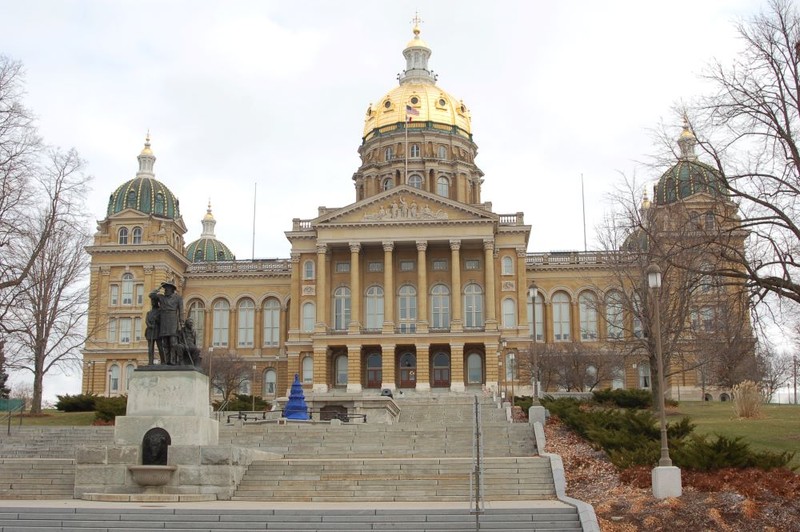Pioneer Statuary Group
Introduction
Text-to-speech Audio
Karl Gerhardt’s Pioneer Statuary Group features a white pioneer man, his adolescent son, and an Indian man gazing out over the Iowa lands the white men intend to settle. Although all three men wear fringed buckskin, differences in their attire, tools and positioning indicate that the indigenous man has yielded his native lands to the white settlers. The bearded pioneer father and his son wear the long European-style coats and hairstyles that late-19th-century white Americans associated with Western civilization, while the fringed buckskin declares their ability to conquer untamed lands. In contrast, the Indian’s bare torso, shaved face and long braids indicate his savagery.
Images
Pioneer Statuary Group

Statue in front of Iowa statehouse

Backstory and Context
Text-to-speech Audio
The earliest western pioneer monuments were erected to mark the closing of the frontier in the 1890s. Pioneer monuments placed during this period consistently depicted American Indians yielding western lands to white settlement. The first completed was Karl Gerhardt’s 1892 Pioneer Statuary Group for Iowa’s state capitol grounds.
This early pioneer monument's design called for "a group consisting of father and son guided by a friendly Indian in search of a home."[1] The resulting Pioneer Statuary Group features a white pioneer man, his adolescent son, and a Native American man gazing out over the Iowa lands the white men intend to settle. Differences in their attire, tools and positioning indicate white dominance. The bearded pioneer father and his son wear the long European-style coats and short hairstyles that white Americans associated with Western European civilization. That their suits are made of fringed buckskin shows their (carefully limited) assumption of indigeneity. In contrast, the Native man's bare torso and face and long braids indicate his lack of Euro-American sophistication.
The white father stands poised to conquer the land using his manufactured ax and Bowie knife. Standing to his right, the pioneer’s son carries a rifle and ammunition, prepared to defend Anglo settlers from wild animals and humans and to provide for them through hunting. They tower over their seated indigenous guide, who gazes back toward the life he has lost. His primitive stone tomahawk and wooden staff are no match for the white men’s manufactured weapons, and reinforce the message that he must yield to white settlement.
Other pioneer monuments installed in San Francisco and Salt Lake City in the 1890s depicted this progression from savagery to civilization even more explicitly, placing white Americans at the top of tall pillars to indicate their cultural superiority.
In 2020, as protesters toppled Confederate monuments and public statues associated with colonialism, Indigenous activists called for the statuary group's removal.
Sources
[1] Iowa Legislature. Pioneer Statuary Group | Pioneer Fountain, Accessed June 28th, 2024. chrome-extension://efaidnbmnnnibpcajpcglclefindmkaj/https://www.legis.iowa.gov/docs/publications/CT/798034.pdf.
"Indigenous activists demand removal of Iowa monuments, restructuring of historical narrative." Des Moines Register July 5th, 2020. https://www.desmoinesregister.com/story/news/2020/07/05/iowa-indigenous-activists-demand-removal-capitol-monuments/5369955002/.
Photo by David Culver
Photo by David Culver
